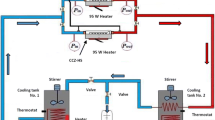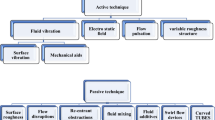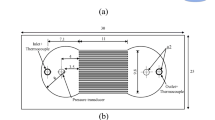Abstract
Miniaturization of the electronic devices and dissipation of the heat generated during the operations within such equipment are of the most important issues in the design of these components. In the current experimental study, it is shown that deploying a cylindrical microchannel heat sink (CMHS) results in a superior efficiency for cooling the equipment when sinusoidally wavy fins are applied with an innovative structure in its geometry rather than the straight ones. The heat sinks considered include 80 straight/wavy microchannels with hydraulic radius of 589 μm and fins of 600 μm in both width and height located on a cylinder. In order to further enhance the heat transfer, alumina nanoparticles were used at three different concentrations, namely 0, 0.1, and 0.3 mass%. In the experiments performed using the base fluid, it is demonstrated that with increase in the Reynolds number in the range of 200–1000, the Nusselt number of the sinusoidal microchannels rises by 6–40% in comparison with that of straight microchannels. In addition, the use of the nanofluid instead of the base fluid further improves the heat transfer coefficient in the both cylindrical microchannels with straight and sinusoidal fins, such that an increase in the concentration of the nanofluid enhances the Nusselt number accordingly. Comparison between the thermal performance of the sinusoidal wavy fins to that of the straight ones in the same conditions (the size and geometry of the heat sink) illustrates that greatly improved thermal performance is achieved utilizing the sinusoidal fins. Also, the application of alumina nanofluids improves the thermo-hydraulic performance index (THPI) of the straight and the wavy CMHSs. The performance index range of 1.05–1.07 and 0.82–1.07 was obtained, respectively, for the 0.3 mass% nanofluid flow in the straight and wavy CMHSs.



















Similar content being viewed by others
Abbreviations
- \(CMHS\) :
-
Cylindrical microchannel heat sink
- \(MHS\) :
-
Microchannel heat sink
- R :
-
Thermal resistance (KW-1)
- k :
-
Thermal conductivity (W m−1K−1)
- A :
-
Area (m2)
- q :
-
Heat transfer rate (W)
- q″ :
-
Heat flux (W m−2)
- N :
-
Number of microchannels
- SH :
-
Shape factor
- T :
-
Temperature (K)
- P :
-
Pressure (mbar)
- P P :
-
Pumping power (W)
- H :
-
Height (m)
- W :
-
Width (m)
- Re :
-
Reynolds number
- h :
-
Convective heat transfer coefficient (W m−2K−1)
- Nu :
-
Nusselt number
- z :
-
Z, Axial distance from the module inlet (m)
- l′ :
-
L′, Microchannel curve length (m)
- a w :
-
Fin cross-section aspect ratio
- Q :
-
Volume flow rate (m3 s−1)
- u :
-
Velocity (m s−1)
- C p :
-
Specific heat at constant pressure (J kg−1 K−1)
- THPI :
-
Thermo-Hydraulic Performance Index
- \(\lambda\) :
-
Wavelength
- γ :
-
Waviness aspect ratio
- δ :
-
Half of wave amplitude
- \(\varphi\) :
-
Volumetric fraction of the nanoparticles
- ρ :
-
Density (kg m−3)
- μ :
-
Viscosity (kg m−1s−1)
- η :
-
Fin efficiency
- ξ :
-
Coefficient of abrupt contraction/expansion
- nf :
-
Nanofluid
- f :
-
Fluid
- p :
-
Particle
- in :
-
Inlet
- out :
-
Outlet
- m :
-
Mean
- th :
-
Thermocouple
- conv :
-
Convective
- fin :
-
Fin
- ch :
-
Channel
- s :
-
Substrate
- mb :
-
Mean bulk
- cond :
-
Conduction
- w :
-
Wall
- av :
-
Average
- cc :
-
Center-to-center of channel
References
Singh R, Mochizuki M, Yamada T, Nguyen T. Cooling of LED headlamp in automotive by heat pipes. Appl Therm Eng. 2020;166:114733.
Torabi M, Karimi N, Torabi M, Peterson GP, Simonson CJ. Generation of entropy in micro thermofluidic and thermochemical energy systems-a critical review. Int J Heat Mass Transf. 2020;163:120471.
Ahmed HE, Salman BH, Kherbeet AS, Ahmed MI. Optimization of thermal design of heat sinks: a review. Int J Heat Mass Transf. 2018;118:129–53.
Sudha G, Parthiban R. Synthesis and characterization of hybrid graphene nanocoolant for heat transfer dissipation in microchannel heat sinks. Chin J Chem Eng. 2020;28(3):913–22.
Ong KS, Tan CF, Lai KC. Methodological considerations of using thermoelectrics with fin heat sinks for cooling applications. Appl Sci. 2017;7(2):62.
Tuckerman DB, Pease RFW. High-performance heat sinking for VLSI. IEEE Electron Device Lett. 1981;2(5):126–9.
Choi SU, Eastman JA. Enhancing thermal conductivity of fluids with nanoparticles. Proceedings of the ASME International Mechanical Engineering Congress and Exposition: Argonne National Lab., IL (United States). 1995.
Zhang H, Shao S, Xu H, Tian C. Heat transfer and flow features of Al2O3–water nanofluids flowing through a circular microchannel—experimental results and correlations. Appl Therm Eng. 2013;61(2):86–92.
Yang M, Li M-T, Hua Y-C, Wang W, Cao B-Y. Experimental study on single-phase hybrid microchannel cooling using HFE-7100 for liquid-cooled chips. Int J Heat Mass Transf. 2020;160:120230.
Tan H, Wu L, Wang M, Yang Z, Du P. Heat transfer improvement in microchannel heat sink by topology design and optimization for high heat flux chip cooling. Int J Heat Mass Transf. 2019;129:681–9.
Jung J-Y, Oh H-S, Kwak H-Y. Forced convective heat transfer of nanofluids in microchannels. Int J Heat Mass Transf. 2009;52:466–72.
Choong JY, Yu KH, Abdullah MZ. Numerical study of heat transfer characteristics of laminar nanofluids flow in oblique finned microchannel heat sink: effects of different base fluids and volume fraction of nanoparticles. J Adv Res Fluid Mech Thermal Sci. 2020;76(3):25–37.
Hedau G, Dey P, Raj R, Saha SK. Experimental and numerical investigation of the effect of number of parallel microchannels on flow boiling heat transfer. Int J Heat Mass Transf. 2020;158:119973.
Asadi M, Xie G, Sunden B. A review of heat transfer and pressure drop characteristics of single and two-phase microchannels. Int J Heat Mass Transf. 2014;79:34–53.
Wang Y, Shin J-H, Woodcock C, Yu X, Peles Y. Experimental and numerical study about local heat transfer in a microchannel with a pin fin. Int J Heat Mass Transf. 2018;121:534–46.
Sohel M, Khaleduzzaman S, Saidur R, Hepbasli A, Sabri M, Mahbubul I. An experimental investigation of heat transfer enhancement of a minichannel heat sink using Al2O3–H2O nanofluid. Int J Heat Mass Transf. 2014;74:164–72.
Sajid MU, Ali HM, Sufyan A, Rashid D, Zahid SU, Rehman WU. Experimental investigation of TiO 2–water nanofluid flow and heat transfer inside wavy mini-channel heat sinks. J Therm Anal Calorim. 2019;137(4):1279–94.
Ahmed HE, Ahmed M, Seder IM, Salman B. Experimental investigation for sequential triangular double-layered microchannel heat sink with nanofluids. Int Commun Heat Mass Transf. 2016;77:104–15.
Ghasemi SE, Ranjbar AA, Hosseini MJ. Experimental evaluation of cooling performance of circular heat sinks for heat dissipation from electronic chips using nanofluid. Mech Res Commun. 2017;84:85–9.
Nassan TH, Heris SZ, Noie SH. A comparison of experimental heat transfer characteristics for Al2O3/water and CuO/water nanofluids in square cross-section duct. Int Commun Heat Mass Transf. 2010;37(7):924–8.
Zeinali Heris S, Nassan TH, Noie SH, Sardarabadi H, Sardarabadi M. Laminar convective heat transfer of Al2O3/water nanofluid through square cross-sectional duct. Int J Heat Fluid Flow. 2013;44:375–82.
Dominic A, Sarangan J, Suresh S, Devah Dhanush V. An experimental investigation of wavy and straight minichannel heat sinks using water and nanofluids. J Thermal Sci Eng Appl. 2015;7(3):031012.
Ali HM, Arshad W. Effect of channel angle of pin-fin heat sink on heat transfer performance using water based graphene nanoplatelets nanofluids. Int J Heat Mass Transf. 2017;106:465–72.
Khoshvaght-Aliabadi M, Feizabadi A. Compound heat transfer enhancement of helical channel with corrugated wall structure. Int J Heat Mass Transf. 2020;146:118858.
Chamanroy Z, Khoshvaght-Aliabadi M. Analysis of straight and wavy miniature heat sinks equipped with straight and wavy pin-fins. Int J Thermal Sci. 2019;146:106071.
Khoshvaght-Aliabadi M, Hassani S, Mazloumi SH. Enhancement of laminar forced convection cooling in wavy heat sink with rectangular ribs and Al2O3/water nanofluids. Exp Thermal Fluid Sci. 2017;89:199–210.
Azizi Z, Alamdari A, Malayeri M. Convective heat transfer of Cu–water nanofluid in a cylindrical microchannel heat sink. Energy Convers Manag. 2015;101:515–24.
Lee J, Mudawar I. Assessment of the effectiveness of nanofluids for single-phase and two-phase heat transfer in micro-channels. Int J Heat Mass Transf. 2007;50(3–4):452–63.
Qu W, Mudawar I. Experimental and numerical study of pressure drop and heat transfer in a single-phase micro-channel heat sink. Int J Heat Mass Transf. 2002;45(12):2549–65.
Li Y, Tung S, Schneider E, Xi S. A review on development of nanofluid preparation and characterization. Powder Technol. 2009;196(2):89–101.
Anoop K, Sadr R, Yu J, Kang S, Jeon S, Banerjee D. Experimental study of forced convective heat transfer of nanofluids in a microchannel. Int Commun Heat Mass Transf. 2012;39(9):1325–30.
Azizi Z, Alamdari A, Malayeri M. Thermal performance and friction factor of a cylindrical microchannel heat sink cooled by Cu-water nanofluid. Appl Therm Eng. 2016;99:970–8.
Das SK, Putra N, Thiesen P, Roetzel W. Temperature dependence of thermal conductivity enhancement for nanofluids. J Heat Transf. 2003;125(4):567–74.
Pham QT, Kim TI, Lee SS, Chang SH. Enhancement of critical heat flux using nano-fluids for invessel retention-external vessel cooling. Appl Therm Eng. 2012;35:157–65.
Pak BC, Cho YI. Hydrodynamic and heat transfer study of dispersed fluids with submicron metallic oxide particles. Exper Heat Transf Int J. 1998;11(2):151–70.
Xuan Y, Roetzel W. Conceptions for heat transfer correlation of nanofluids. Int J Heat Mass Transf. 2000;43(19):3701–7.
Maxwell JC. A treatise on electricity and magnetism. Oxford: Clarendon Press; 1873.
Maiga SEB, Palm SJ, Nguyen CT, Roy G, Galanis N. Heat transfer enhancement by using nanofluids in forced convection flows. Int J Heat Fluid Flow. 2005;26(4):530–46.
Holman J. Heat Transfer. 10th ed. New York: McGraw-Hill; 2009.
Khaled AA. Thermal performance of six different types of wavy-fins. Int J Numer Method Heat Fluid Flow. 2015;25:892–911.
Fernández-Seara J, Uhia F, Sieres J. Laboratory practices with the Wilson plot method. Experim Heat Transf. 2007;20(2):123–35.
Naphon P, Nakharintr L. Heat transfer of nanofluids in the mini-rectangular fin heat sinks. Int Commun Heat Mass Transf. 2013;40:25–31.
Kandlikar SG. Effect of liquid-vapor phase distribution on the heat transfer mechanisms during flow boiling in minichannels and microchannels. Heat Transf Eng. 2006;27(1):4–13.
Roberts NA, Walker D. Convective performance of nanofluids in commercial electronics cooling systems. Appl Therm Eng. 2010;30(16):2499–504.
Huang H, Wu H, Zhang C. An experimental study on flow friction and heat transfer of water in sinusoidal wavy silicon microchannels. J Micromech Microeng. 2018;28(5):055003.
Moffat RJ. Describing the uncertainties in experimental results. Exp Thermal Fluid Sci. 1988;1(1):3–17.
Peng XF, Peterson GP. Convective heat transfer and flow friction for water flow in microchannel structures. Int J Heat Mass Transf. 1996;39(12):2599–608.
Khoshvaght-Aliabadi M, Sahamiyan M. Performance of nanofluid flow in corrugated minichannels heat sink (CMCHS). Energy Convers Manag. 2016;108:297–308.
Webb RL. Performance evaluation criteria for use of enhanced heat transfer surfaces in heat exchanger design. Int J Heat Mass Transf. 1981;24(4):715–26.
Acknowledgements
Authors would like to appreciate the South Pars Gas Complex (SPGC) for their financial support of this research.
Author information
Authors and Affiliations
Corresponding authors
Additional information
Publisher's Note
Springer Nature remains neutral with regard to jurisdictional claims in published maps and institutional affiliations.
Rights and permissions
About this article
Cite this article
Goosheneshin, A., Alamdari, A. & Setoodeh, P. Experimental examination of the cooling performance of a cylindrical microchannel heat sink with straight and sinusoidal fins and alumina nanofluid coolant. J Therm Anal Calorim 147, 7573–7588 (2022). https://doi.org/10.1007/s10973-021-11039-z
Received:
Accepted:
Published:
Issue Date:
DOI: https://doi.org/10.1007/s10973-021-11039-z




